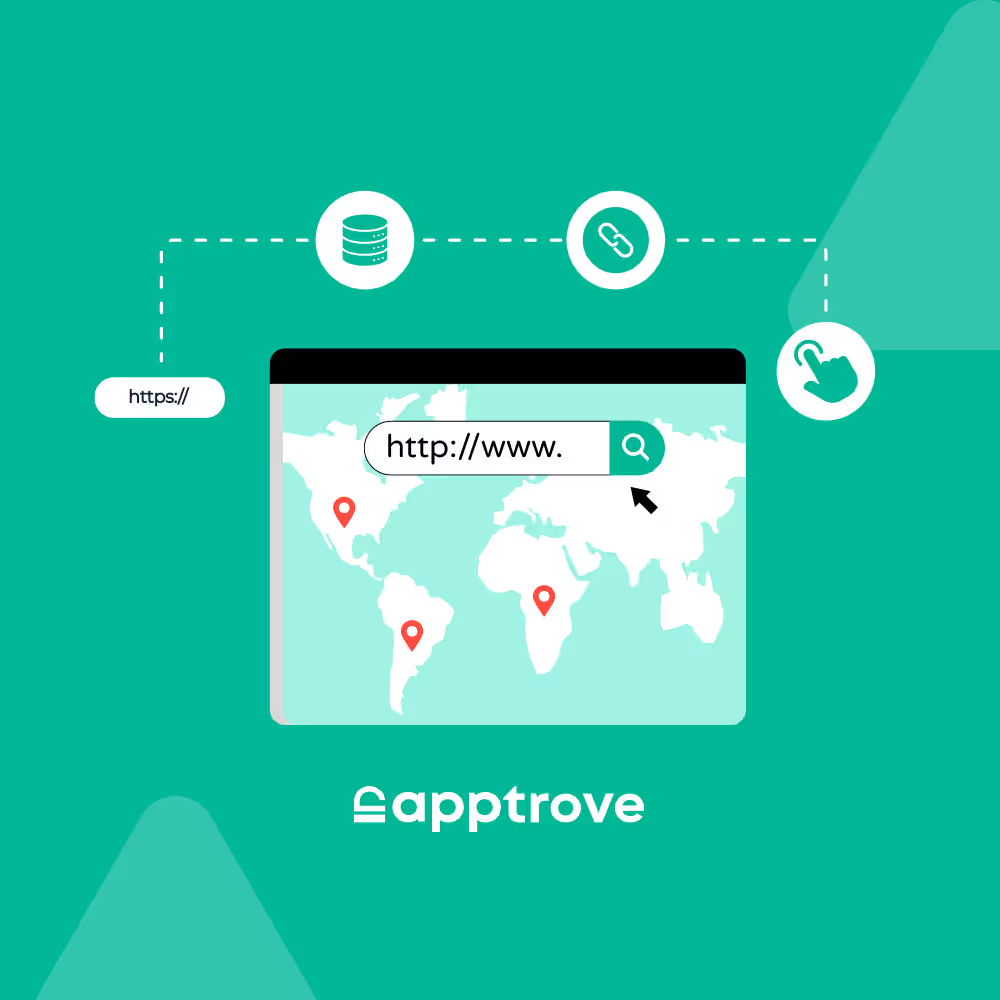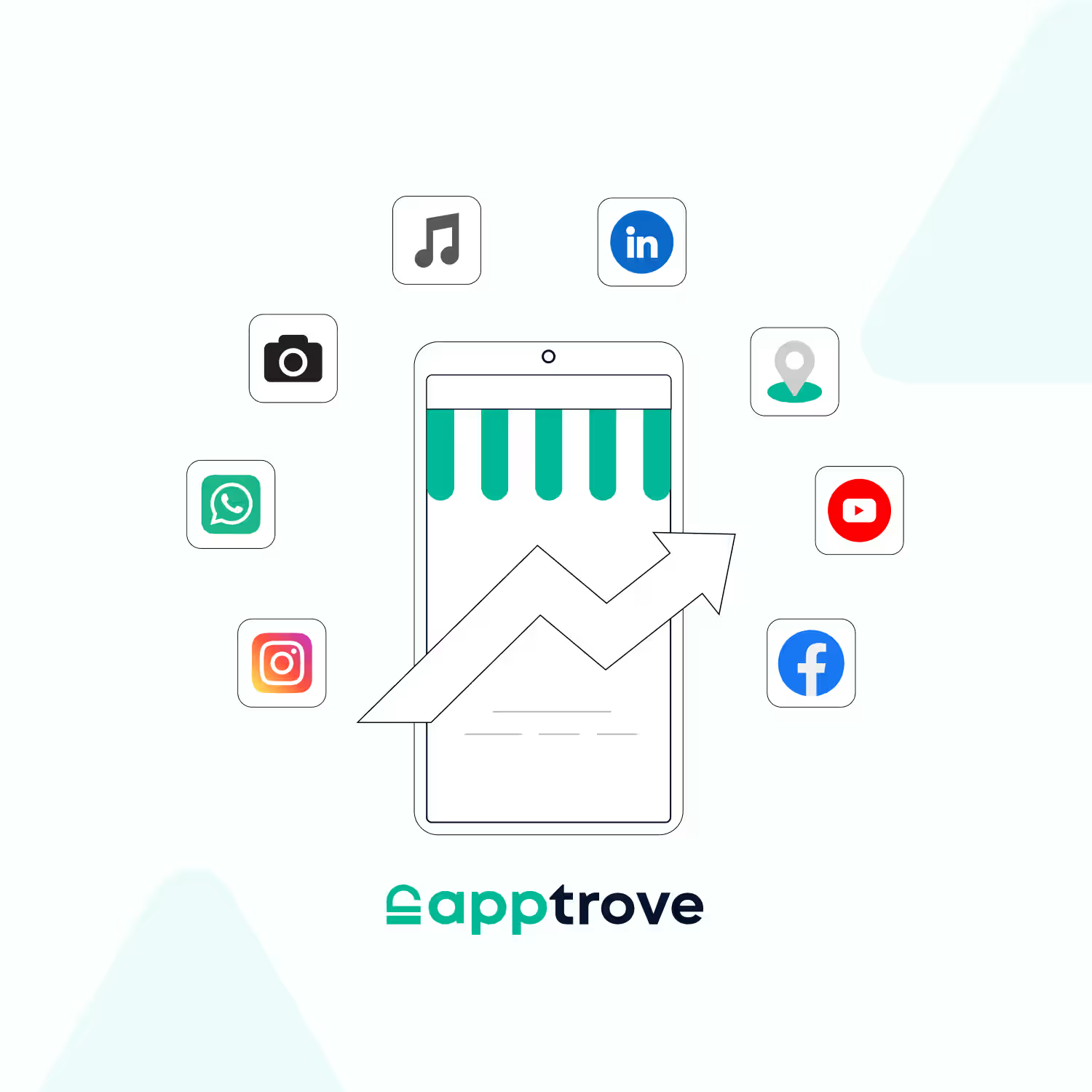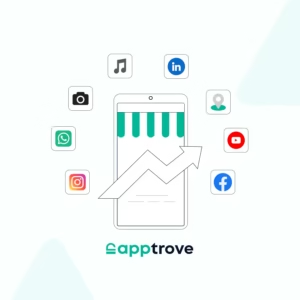Introduction
You’ve likely hit a hundred links today without a second thought as to where those links are originating, who built them, or what stories they are telling behind the scenes. But when you build a campaign, suddenly links are the marketers’ unquiet narrator of the marketing journey. Learning the process of create or tracking URLs is less about the technical aspects, and more about reading people.
Each link a user clicks is not just a “link,” it’s a moment of curiosity, desire, or trust. Tracking a URL is not about documenting behavior; it’s about decoding a single human decision, meaning created by the click. Yet, only 39% of companies carry out attribution on all or most of their marketing activities — leaving many links unmeasured and stories untold.
But link building is often relegated to a last minute chore, overcome as just another item on the checklist to build a Campaign.
At Apptrove, we think differently. Clean, considered URL tracking is the foundation of any real analysis story, a habit that brings you clarity, context, and confidence. But the true value comes not from the tools themselves, but rather from you, the decisions you make, the journeys you build, and the insights you intend to understand.
At the end of this guide, you won’t just know how to create or track URLs the “right way,” but rather understand why it is one of the most human elements in marketing.
Why Learning to Create or Track URLs Alters Your View of Your Users
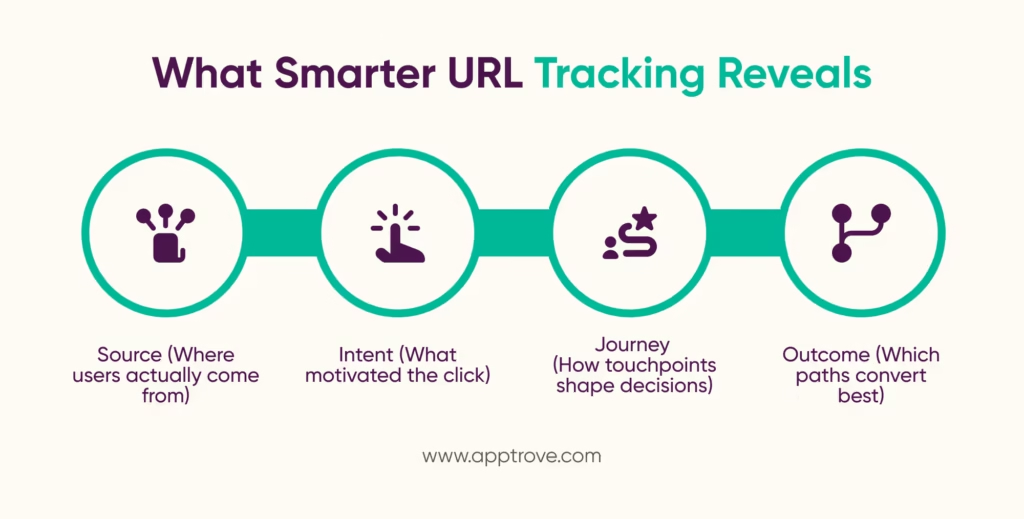
When you familiarize yourself with generating or tracking URLs, something subtle shifts but it’s a powerful shift. You stop viewing traffic as simply numbers on a dashboard — and you start to view each click as a small decision that a real person is making with context, intent, and emotion behind it. Knowing link journeys makes you more empathetic as a marketer because you start to see why users are behaving the way they do.
A link is not about “just a link.” It’s the beginning of a journey.
A journey that uncovers where a user has come from, what caught their eye and ultimately what kept them or encouraged them to leave the journey. Once you start to decode these journeys, you do not just optimize campaigns — you build perspective about people.
This shift matters even more today, considering that 63% of internet users feel brands are not upfront about how they handle personal data.
This is the reason why with us, we often refer to tracking URLs as not a technical skill, a lens through which you have a better and more thoughtful way to read user journeys without intruding on privacy or over-collecting data. It is about understanding how different touchpoints shape intent — and how intent shapes conversion.
When URL creation is executed properly, you will receive cleaner data. When tracking is carried out properly, you will receive context. When you effectively combine both, you will receive something far more important: clarity.
Clarity about what works, what doesn’t, and what your users genuinely care about.
In a digital world defined by bouncing between platforms, devices, and apps, clarity parallels core-level insight. Creating or tracking a URL allows you to track that fragmented path- in an ethical, transparent manner, with respect for the user’s choice.
Whether you are running paid campaigns, doing creative testing, creating personalized onboarding, or measuring retention rate, the journey truly begins here. When you appreciate the craft of link tracking it’s an opportunity to see your marketing differently, your users differently- and your results will follow.
The Authentic Appeal of Tracking Links
The real magic of tracking links is not in UTMs, parameters, or dashboards — it’s in the moments they show you. Every tracked URL is a snapshot of a decision: a click that communicated “This caught my eye; this matters to me or “I’m curious, tell me more.”
When you track a link, you are listening to your users without distracting them. You are learning about where your users came from and what stood out to them. You are following their journey, step by step.
Marketers often focus on impressions and conversions, but link tracking shows you the part in between it all, when awareness transfers to interest and interest becomes action. In that middle space lies real understanding.
So, if you want to gain real insights without being too data-heavy, tracking URLs is the quiet, powerful storyteller you have been searching for. It connects every dot you have ever cared about.
Why Privacy-First World Demands Smarter Tracking
We are currently living in a world where the expectations of users include transparency, control, and respect for their decisions regarding privacy. This means that traditional tracking techniques, such as cookies, cross-app identifiers, or passive capture of data, no longer fit the moment.
This shift is undeniable, with more than 90% of consumers now preferring brands that clearly communicate how their data is used.
Building or tracking URLs provides marketers a privacy-first option to understand performance without crossing the line. Rather than relying on signals that are hidden you are relying on intention signals. A click. A campaign. A clean set of parameters.
This reason is one driving modern teams to move to link-based measuring. Because it is accountable, transparent, and reliant on user action, not user surveillance.
In a privacy-first ecosystem, shaped by SKAN, ATT, and stricter global regulations, more intelligent tracking is not a nice-to-have; it is the only way to grow that is sustainable. URLs become your lifeline. URLs make attribution clearer, and user paths measurable as well as reporting defensible.
More intelligent tracking is not about collecting more data.
It is about collecting cleaner, consented-to data. The type of data that respects the user, and still helps you win.
What a Tracking URL Is Made Of, And Why It Matters When You Create or Track URLs
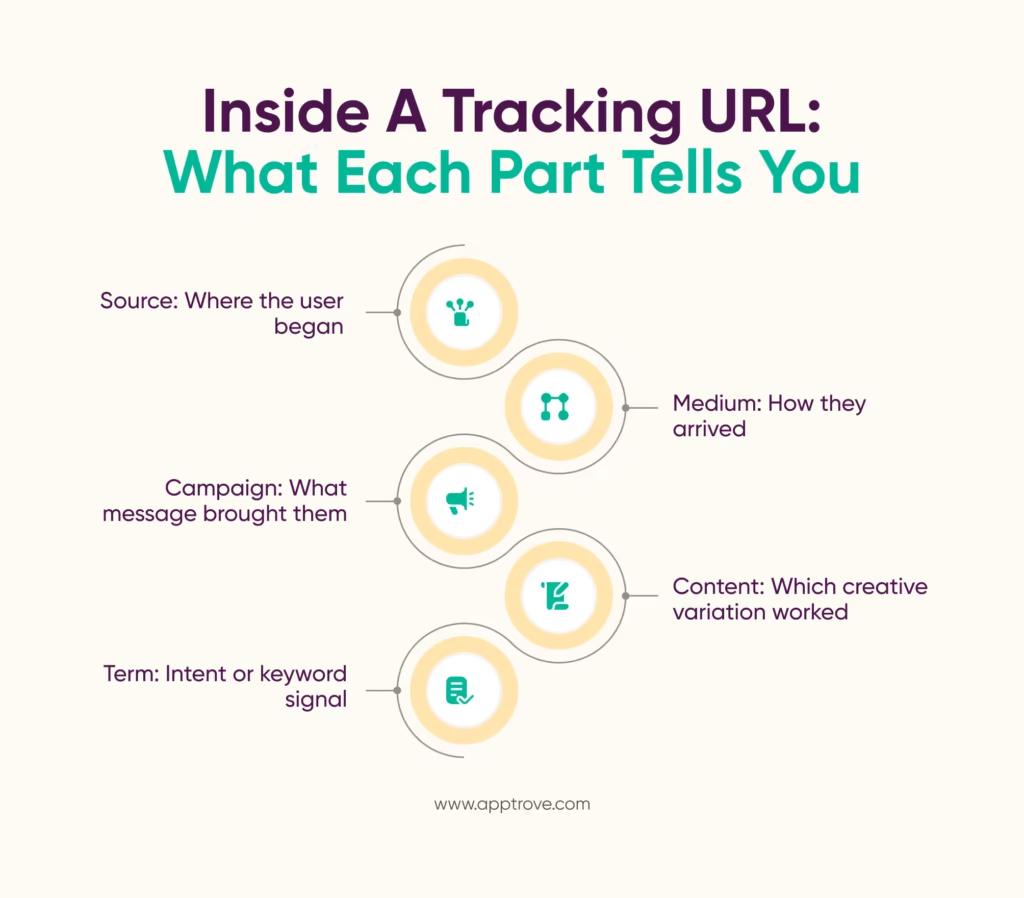
If you view a tracking URL for the first time, it may look like just a disjointed string of characters. Once you understand what each part is and how they each fit together, the string of characters starts to look more like an incantation than a mixture of letters. An incantation that will help you understand users (or lack of), measure intent, and make informed decisions.
Getting used to creating or tracking URLs is not just a technical step; it is a way to structure your marketing. Each parameter that you add is another clue to help you decipher the story behind a click. Was the user coming from an email? A specific creative? A holiday offer? A retargeting campaign? Your URL can tell you – when you create it intentionally.
An intelligent tracking URL will spare you from dealing with uncertainty. It will provide an answer to the question of understanding where each campaign began and where each ended with proof. With no tracking URL, your reports turn into 1,000-piece puzzles: you get to see results, but no information on where the results came from. In a world of multi-touch, that recognition of the path is half the battle.
The power comes from how those URLs play out across screens and platforms. Having a user come from Instagram, a holiday email, a pre-roll on YouTube, or a partner website means the tracking URL should connect the dots for you. The URL tells you what worked, but also why it worked, sometimes walking you through what didn’t work.
Once you start viewing URLs like you read stories, instead of digesting strings, you will find yourself crafting better campaigns at the start. You will know the messages that land, the platforms to care about, and the journeys with the highest intent. In a world where consumer privacy, consent, and transparency mean more than they ever have, a clean tracking URL is not just nice to have, but the responsible thing to do.
A good URL is simple.
A great URL is intentional.
The best URLs allow you to understand your users without any intrusion on their trust.
Every Tracking URL has a Backstory built into it.
Every tracking URL is a little story. At first, it may look like parameters and symbols — but under the surface lies the experience of a person making a decision. When someone clicks a link, they’re choosing to take a step forward. That step has significance, and a tracking URL will help you understand that significance with surprising depth.
To illustrate, Each of those parameters is a storyteller.
One tells you the users’ origin.
One tells you about the message that got him/her interested.
One tells you about the best working format.
Once you learn how to design or track URLs with purpose, you start decoding these micro-stories with ease. You see trends that others disregard. Which creative raised curiosity, which headline nudged someone towards conversion?
A click reflects a moment — and each moment reflects a story. A tracking URL simply helps you read it.
Why Parameters Are More Important Than You Think
Parameters may be small, but they are mighty. Parameters help determine what data you will collect, how accurate your attribution will be, and how certain you can be in your campaign analysis. When a parameter is missing, it is not just a missing field; it is a missing insight.
For example, if you add a broad source but you don’t include the medium, you will have an understanding of where your traffic came from but no understanding of how it got there. If you omit the campaign parameter, you won’t know what message was effective. Tracking URLs function like building blocks: remove one, and the overall structure weakens.
In today’s world of marketing budget scrutiny and fragmented consumer journeys across channels and platforms, parameters become your precision tool. Parameters reduce ambiguity, enable improved reporting, and add strength to even the smallest insight.
When you create URL’s you put your parameters to work for you. Your hypothesis becomes a journey of discovery that guides your decision making, sharpens your strategies, and ultimately helps you turn scattered signals into a distinct and confident direction.
How to Create or Track URLs without Chaos in Your Campaigns

Every marketer knows this feeling: the campaign is robust, the creatives are gorgeous, the copy is crisp – then the tracking URLs come in a cluttered, last minute pile and suddenly everything feels out of control. The sources don’t match, the parameters aren’t consistent, and some tracking URLs look sketchy. The reporting? It’s all guesswork instead of storytelling.
The chaos that ensues is because URL tracking and construction are often seen as an administrative task rather than a strategic one. When you create or track URLs strategically, your campaigns are no longer puzzles. There’s context with every click, there’s clarity with every channel, and every insight feels like you’ve earned it instead of making it up.
A cleaned URL structure not only provides more accurate analytics but also changes the way we think about the way we design our campaigns. It brings a sense of peace to the way we plan, execute and measure our efforts. You can prioritize what actually matters. And most importantly, it protects you from the kind of data confusion that erodes trust and wastes budgets.
You shouldn’t have to decrypt your own marketing.
That is what a great URL does for you.
Once you begin structuring your URLs with clear formats and consistent elements, you’ll feel different. The messages you communicate will feel aligned. The channels will feel less unpredictable. Attribution will feel less noisy. And even internal collaboration will be easier because everyone will be able to communicate using the same vocabulary.
The goal is to build the habit, the structure, and the mindset that keeps URL tracking clean, valid, and useful.
Because the truth is straightforward: campaigns do not fail because the idea was a bad idea. Campaigns fail because the data was a mess. And URL hygiene is one of the few habits that will keep you from getting a mess every time.
Constructing Tracking URLs for Every Channel with Which to Engage
Different channels require different energies to roll out a campaign, but your tracking URL should consolidate all that energy into a single container. Whether you’re generating a holiday email blast, building out a social media carousel, creating a paid search ad, or writing a personalized push notification, constructing or tracking the URL should be uniform.
For paid campaigns, each URL should disclose the channel and intent for the ad post, and if it’s running on Instagram Stories, that URL should clearly communicate that fact. Not in an obscure abbreviation, but clear enough, for future-you to read without question. For email, your parameters should separate out messaging for newsletters, promotional messages, retention message flows, or seasonal messages, and if you engaged influencers or partnerships, it should indicate which influencer or partner created which audience.
Each channel provides a different window into user behavior. However, your tracking URLs are the stitching that nodes that window together into one view. Construct them with intention, and every touchpoint will generally communicate the same messaging and thing.
The Mistakes Marketers Make When They Create or Track URLs
Mistakes involving URLs rarely look substantial. These are small and quiet mistakes — but each one has implications.
The first mistake is inconsistencies. When a team uses different naming styles across channels, there is chaos in reporting. The second mistake is too much information: URLs that are overloaded with parameters seldom clarify anything and often create confusion. The third mistake is skipping parameters altogether, which requires your analytics tool to make assumptions about what happened to the user interaction — and I’m sure you already know that assumptions do not aid your optimization efforts.
A very subtle mistake is using strange shorthand. What seems obvious today will be impossible to read in six months. And the biggest mistake? Not documenting anything. Team members think they will remember the structure- until they realize six months later that they don’t remember.
These mistakes do not necessarily break a campaign — but they break your understanding of the campaign. Understanding is everything.
Why Clean Naming Conventions Will Benefit Your Future Team
While naming conventions may not seem as exciting as other, more glamorous concepts, your future self — and every person you will work with in the future — will appreciate the work you put into naming conventions. When you create or maintain URLs in a predictable pattern, the most amazing part is that everyone knows what they are looking at, even if they didn’t build it.
Clean naming conventions remove friction in reporting cycles. They reduce the time you spend deciphering URLs. They limit the misattribution as you are building dashboards. And they give new team members clarity as soon as they arrive.
Good naming conventions are not hard and fast rules to follow, but rather guardrails that help your team avoid extreme inconsistency. And with good naming conventions in place, mistakes become less frequent, handoffs become cleaner, and campaigns can scale without losing their form.
Your tracking will never be cleaner than when your naming is consistent.
How to Track URLs in Web, Social, and Mobile
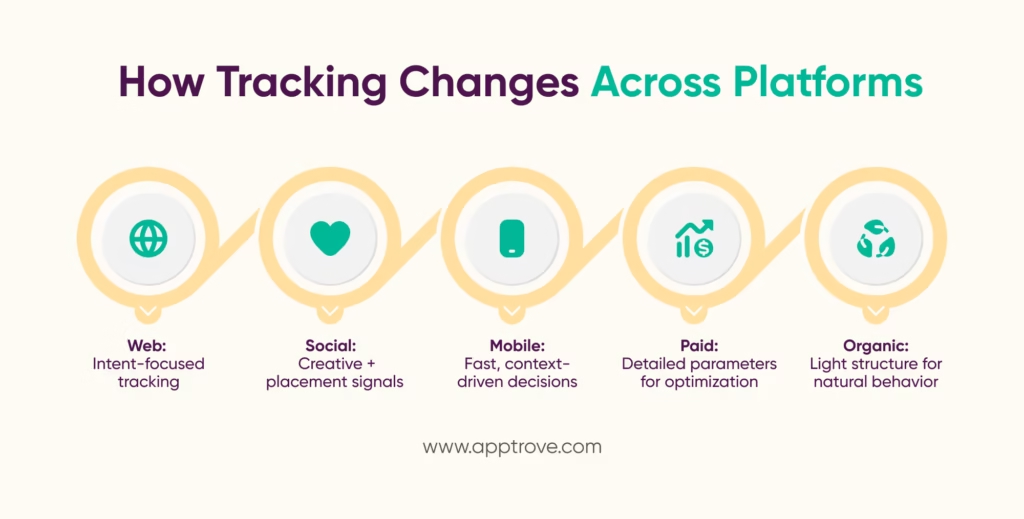
When you step back and assess your user journey across different platforms, one thing stands out: people respond differently to where they meet you. Someone who sees your brand on Instagram is not the same person who scrolls your website late at night, nor someone who clicks on the link in the push notification from your mobile app. Their mental state is different. Their expectations are different. As such, how you create or track URLs has to shift.
Tracking URLs across different channels is not about achieving perfection. It is about respecting the context of how people find you. On the Web, clicks are typically more deliberate. On Social, clicks tend to be earned through curiosity or discovery. On mobile, decisions are made quickly and instinctively, typically out of convenience. Tracking URLs helps you understand those little moments without ever needing to encroach on the user.
It offers an avenue for measuring motion in a new dimension: not just how many people clicked, but how they clicked, where they came from, and what mindset they may have been in at that time. If the same structure appears every time, your data is a dialogue between platforms — one that displays patterns, preferences, and revelations, and that would be kept secret otherwise.
When you begin to think of URLs as signals of real human behavior as opposed to strings of cryptic text, you begin to analyze with empathy. You move from guessing to understanding. And this clarity helps you build experiences that feel more intuitive, more personal, and most importantly more effective.
The Ever-Changing Story Your Tracking URLs Tell From Platform to Platform
Every platform changes the narrative your tracking URL can tell. Specifically, the web offers you parameters to better understand user intent: were they browsing, comparing, researching, or ready to buy? Because desktop sessions are often more involved, your URL structure needs to reflect that — clearer campaign names, more meaningful content parameters, tighter naming conventions.
On social media, now everything happens fast. Users scroll, pause, swipe and jump. Your tracking URLs should be able to capture that energy. You choose parameters that are thought of specifically for the platform — placement, creative type or sample audience variation. The more you can individualize your URL usage to the behavior on social, the better you can understand which emotions or formats catalyzed action.
On mobile — especially inside apps, or the notification screen, URLs need to be light, clean, and agile. Tracking decisions made in seconds – the kind of decisions that can be shifted with a small nudge.
On each platform we’re telling a small part of a yet-to-be-told story. All your tracking URLs are doing is helping you listen.
The Nuanced Differences of Tracking Paid vs. Organic Traffic
Paid traffic and organic traffic behave differently, your URLs need to know that. Paid traffic typically has clear goals and structured implementations. As a result your URLs need detailed parameters such as creative variables, target groups, placement, content types, etc. All of these variations allow you to optimize clicks efficiently, as every paid click has costs and opportunities.
Organic traffic is different. It can be based on curiosity, search intent, a recommendation from content someone may have consumed, or brand recognition (e.g. seeing your logo). Your tracking here should be light, but intentional, with simple parameters to help you understand which touch points had an influence on trust without cluttering your data with noise.
The basic difference is obvious – paid traffic is based on motivation: paid users are there because you invited them. Organic users are there because they were already looking. Tracking URLs allows you to understand the mindset of the users when they click a paid advertisement vs. organic discovery, and to inform your future approach to strategy.
Insights into Real Behavior Through URL Tracking
URL tracking does not simply show you what the user clicked on, but why. It illustrates curiosity peaks, moments of drop-off, creative impact, channel influence, and even nuanced behavior. It gives you insight into the messages and experiences that resonate with people, the platforms that sparked success, and what user journeys convert naturally.
When you create or track URLs intentionally, you’re not recording data; you’re recording understanding. And it’s that understanding that transforms marketing into a more human aspect — patterns expose needs, stories expose motivations, and insights expose ways in which people have chosen to navigate their journey through your brand.
Mobile Journeys Aren’t Straightforward — Here’s How to Create or Track URLs That Work in Apps

The web functions like a straight path. Mobile works like a maze. One moment, a user’s scrolling through a social feed, the next they’re in an app, then back into a browser, and finally back to the app, presumably without remembering they had pushed it yesterday. Mobile journeys are nonlinear, emotional, spontaneous, and at times delightfully chaotic.
Because when you create or track URLs for mobile, your task is not just getting a user from one point to another. You are directing a user through an experience of their choice, in a way that feels natural, safe, and uninterrupted. A single misdirected or misplaced link can completely disrupt the flow: a wrong screen, stuck in the app store, or simply abandoning the journey because the routing didn’t work.
Mobile journeys are layered as well. A tap in an advertisement does not function the same as a tap in a browser. A link in WhatsApp is not the same as a link in an email. And every time a user switches applications, they also switch their emotional state. They are either curious, impatient, hopeful, distracted, and your tracking URL must respect that moment in time.
Mobile routing is not about forcing someone into an application. It is about helping them find the exact destination they intended, without friction or confusion. When you are able to track URLs across mobile channels to facilitate this process, you are not only collecting behavioral signals, but also building trust with your user. Users never forget a seamless experience. Users also never forget a non-seamless experience.
As journeys become increasingly fragmented and privacy demand increases, the art of thoughtful mobile URL creation becomes increasingly important. You are not chasing the user; you are simply meeting the user where they are and leading them exactly where they intended to go.
Mobile Routing is More Emotional Advancement than Technical Advancement
On mobile, every tap feels meaningful. People use phones closely, thrusting through their use, and expect them to “just work.” For this reason, mobile routing is more emotional than technical. You are dealing with micro-moments – the moments where a user decides to stay or leave in a split-second decision.
If your routing sends them to the wrong place for even a fraction of a second, they’re frustrated. If your link leads to a page telling them they need to log in again, their patience is gone. But, if the routing is smooth, if the link takes them to the right screen, the right content, the right offer, it feels seamless. Invisible. Effortless.
The emotional part isn’t in the coding. It’s in the expectation. When you create or track URLs on mobile and truly empathize with your automated users, you help the user feel understood. And feeling understood is what drives the user forward.
Understanding Deep Linking as If Explaining to a Friend
Let’s say you invite a friend over, and they ask for your address. Instead of giving them your apartment number, you just tell them the building. Your friend arrives, walks inside, looks puzzled, then calls: “Where should I go now?”
This is what a standard URL does to a user on mobile.
Deep linking is when you tell your friend which door to knock on. The user doesn’t just find their way into your app; they land directly on the screen they expected—the product page, the offer, the cart, the profile, the video, the exact moment that led them to click.
Deferred deep linking is when they don’t even have your app yet. They install the app, they open the app, and they land on the intended screen. It’s like remembering the address for them, except it’s a mobile experience.
When you create a link, or track a URL, or create deep links, you are removing friction from the journey. You are making it feel as though your app is smart, welcoming, and in tune with their intention. It’s almost like you were expecting them.
How Privacy Shapes the Way You Track Mobile Journeys
Mobile privacy is not an impediment — but rather, it is behavior modification. Consumers expect more responsible actions, more transparency and control, and less of a tracking footprint. When tracking URLs on mobile, you are operating in a world where consent prompts impact your tracking, your OS has tracking restrictions, and your content may be in an encrypted ecosystem.
This does not prevent you from tracking; it requires more intentionality.
Instead of tracking everything, you’ll be tracking what really matters. Instead of building complex URL structures, you’ll be building clear, purpose-driven URL structures. When users opt in to provide shared signals, you need to be responsible, safe, and meaningful in the way you respond to them.
The future of mobile tracking is not about tracking more; it’s about tracking better.
Defining Success: What You Truly Learn from Creating or Tracking URLs
After your URLs are live and our users begin to click through them, our process shifts from development and creation to the interpretation of meaning. Tracking becomes less about numbers and more about understanding themes, emotions, and signals in the deep background. When you create or track URLs with shape and purpose, the insights that come from are valuable and will impact everything from your creative decisions to your channel strategy, to how you tell the story of your brand.
The most common assumption is that URL tracking is exclusively about performance. URL tracking is about personality. We see the things that our users react to, which messaging resonates, which social media channels impact thought, and where they drift along their path. We see curiosity and engagement and when it fades away. We see how audiences behave when there’s no one in the room watching. The more you’re consistently tracking your URLs, the deeper those stories get.
This matters because the median click-through rate across industries is only about 1.51%, showing how rare meaningful user actions actually are without clear, intentional URL journeys behind them.
You’re not measuring clicks; you’re measuring patterns of human behavior.
And that is where the real value is.
Characteristics That Count
The dashboard can be overwhelming with numbers, and the inclination is to review everything. URL tracking is good when you hone in on the characteristics that showcase behavior.
First, click-through rates demonstrate interest — not just that an individual saw your message, but that it resonated with them enough to prompt them to take action. Second, conversion rates showcase intent and alignment — meaning the person was satisfied with what they discovered after clicking. Third, source and medium attribution identifies where your most engaged users are located, understanding how each platform fills a role in your ecosystem.
Journey completion rates are particularly useful on mobile devices because one wrong routing can interrupt the journey. The journey completion rate signifies whether users reached the screen they were promised. Fourth, engagement depth demonstrates how far they traveled, how long they stayed, and what engaged their attention.
Every metric is a clue. Once you develop or track URLs with the correct parameters, these clues tell the story, which tells you how to refine your message, enhance your strategy, and ultimately deliver experiences that feel more intuitive each time.
Transforming URL Metrics Into Campaign Optimizations
Data only becomes useful as a tool when you use it. URL metrics show you where your campaigns are working in correspondence (or lack of) to user behavior. If one platform consistently drives deeper user engagement, it might be worth shifting more ad budget or creativity towards that platform. If one message resonates better with users and converts more than other messages, that tone or language might be the right direction for your next campaign.
When URLs expose drop-off points, you can fix broken user journeys. When URLs expose continuous patterns, you can get more targeted with content personalization. When URLs expose the best entry points, you can improve your targeting and build campaigns based on people’s known intent.
The real power of URL tracking isn’t in its precision; it’s in its adaptability. Each insight gives you a minor advantage, and when combined those advantages across multiple channels and campaigns, you ultimately build a strategy that feels sharper, more relevant, and far more aligned to what your users actually want.
Behavioral Patterns You Will Only See From URL Tracking
Some patterns will only emerge when you observe a large number of URLs. You naturally pick up on which parts of the day create curiosity, which platforms lead to faster conversions, which content formats create more dives into your site, and which journeys stall quietly.
You start to see the emotional tension of your users: when they glance, when they commit, when they compare, when they hesitate.
And because every URL you track has context (source, medium, campaign, content), these patterns will, over time, map your audience’s behavior in the real world, a map on which you can publicly build your whole strategy.
How Apptrove Keeps Your URL Tracking Clean, Consistent, and Privacy-Ready
Once you start creating and tracking URLs across channels, you’ll realize something incredibly quickly: chaos is the natural state of things. Every team names things differently. Every channel contributes a parameter of its own. Every campaign has “just one more version”—and before you know it, your data looks like it’s speaking five different dialects of the same language.
This is exactly where a structured, privacy-aware system helps, and where we tout, becomes the backbone of your tracking layer. Not because you need yet another tool, but because you need a single source of truth that doesn’t break apart the moment you bring in a new platform, team member, or creative idea.
A clean tracking setup is not necessarily about UTMs or URLs, but about ensuring that everyone sees the same story. We help keep parameters consistent, automate naming conventions you would have built manually, and ensure that every click – whether it originates from web, social, or mobile – conveys meaning, not noise.
The real win is in privacy readiness. As platforms impose more restrictions on identifiers and tighten their policies, messy tracking is the first thing to break. Properly governed URLs, validated parameters, and privacy-oriented routing enable you to continue learning about your audience, without going beyond what’s permitted (or expected).
And when your team scales, new channels pop up, or privacy protocols change again, your tracking remains steady – not because you kept up with every change, but because you built your foundation for clarity from the jump.
The Future of Building or Tracking URLs as a Marketer
AI Will Change the Way You Build Tracking Links
Very soon, you won’t create or track URLs in even a remotely recognizable fashion. You won’t open spreadsheets, copy UTMs or worry if a teammate more likely types “spring_campaign” or “spring-cmp.”
You will just describe what you are launching — “a retargeting campaign for people who saw product X” — and AI will build the URL, the parameters, the naming convention, and even the routing logic in an automated fashion. In fact, 88% of marketers say they already use AI in their daily marketing roles.
Instead of managing the structure, you’ll manage the intention.
AI will turn your goals into tracking logic, identify inconsistencies before they break your data, and correct forces you most likely forgot to check. You will create or track URLs without touching a single parameter, because machines will build the grammar of tracking and you will focus on the story of the things you did track.
Privacy Will Drive You Towards More Ethical Tracking
The evolution of privacy laws will create a scenario where marketers will finally feel empowered to do what should have always been the default: tracking people, while still offering valuable insights.
You’ll depend less on identifiers and more on patterns. Less on personalized, granular data and more on contextual signals. The future of URL tracking will no longer be about maximizing every single detail of a click, but rather truly understanding behaviours without crossing thresholds.
Ethical tracking will not slow you down – it will make your insights sharper. When people feel comfortable with the data collection process, they will provide you with more of their data. Clean consent flows, privacy-ready parameters, and smooth routing will become the new update.
Adaptive Links Will Automatically Personalize Journeys
The next generation of URLs won’t simply “send traffic somewhere.” They will respond.
Imagine one link that understands whether someone is on Android, iOS, desktop, or inside another app — and quietly picks the easiest path. No hassle. No cul-de-sacs. No more manual mapping for all the platforms.
Adaptive links will read the context in real time and personalize the journey without being disruptive:
A new user sees onboarding.
A recurring user picks up where they left off.
A loyal user goes right to their saved preferences.
All of the technical magic will happen under the hood; all the user will feel is that everything “just works.”
For marketers, the future will feel like “fewer steps, fewer mistakes, fewer fixes…and more time being creative and actually moving people.”
Your Final Thoughts — The Immutable Need to Create or Track URLs
At its core, tracking URLs has never been about parameters or redirects. It’s always been about people; the moment they pause, think about it, and click. When you create or track a URL, you’re not just tracking a path; you’re learning about what piqued curiosity, what built trust, and what made a user feel that link was worth clicking.
Even as tools evolve and journeys become more disjointed, a trustworthy constant is that every digital story starts with one deliberate tap. And understanding that moment will always matter. URL tracking gives you the language to understand that intent — not as a technical exercise, but as a way to identify nuances, kindness, and clarity in a user’s behaviour.
Every link is a small invitation. URL tracking lets you understand who accepted your offer, and why.
If you’d like to know more about this, feel free to contact us or even try it for yourself using a free trial – sometimes the best way to understand a journey is to just walk through it.
